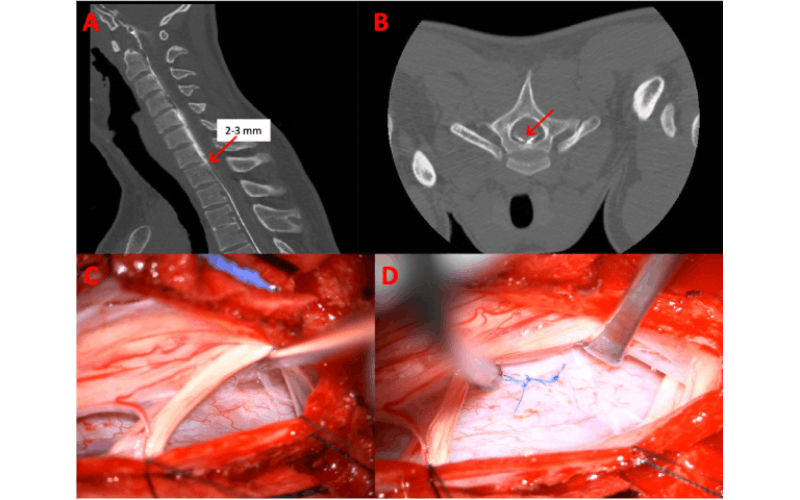Cerebrospinal fluid (CSF) leaks are relatively rare but frequently misdiagnosed, due to the nonspecific symptoms with which patients may present. NewYork-Presbyterian/Weill Cornell Medicine recently established a dedicated CSF Leak Program. Co-directed by Gayle Salama, MD, a neuroradiologist and Director of Spine Imaging and Interventions at NewYork-Presbyterian/Weill Cornell Medicine, and John Park, MD, PhD, Chief of the Department of Neurological Surgery at NewYork-Presbyterian Queens, the program is one of the few dedicated multidisciplinary programs in the Northeast offering advanced imaging technologies to identify the presence and source of cranial and spinal CSF leaks as well as surgical and endovascular treatments to manage them.
"CSF leaks can be complicated, difficult to locate, and challenging to treat," says Philip Stieg, MD, PhD, Chair and Neurosurgeon-in-Chief at NewYork-Presbyterian/Weill Cornell Medicine. "Our neuroradiologists, neurologists, and neurosurgeons collaborate closely to determine the best diagnostic pathway and course of treatment for each patient."
A Challenging Diagnosis
A positional headache, one that is worse in the upright position and improved in the supine position, is suggestive of a spinal source of CSF leak. Many patients however do not experience this classic symptom and instead present with a variety of symptoms that could be due to other etiologies. Non-specific symptoms of spinal and cranial CSF leaks include:
- Non-positional chronic headache
- Runny nose
- Hearing loss
- Pulsatile tinnitus
- Dizziness or vertigo
- Clear fluid discharge from the ears
- Fevers, chills, sensitivity to light, and neck stiffness
- Pain in the neck or shoulders
- Nausea
- Visual disturbances
- Changes in memory, thinking, or behavior
Because these symptoms are not specific to a CSF leak, patients may be misdiagnosed, sometimes for many years. "Patients' symptoms often overlap with other etiologies. Because CSF leaks are relatively uncommon, they are not at the top of most physicians' differential diagnosis lists," explains Dr. Park. "Once a CSF leak is eventually suspected, it can be difficult to identify its location with standard imaging."
That's where the CSF Leak Program comes in. "We offer advanced imaging techniques to identify the presence and location of leaks," adds Dr. Salama. The program offers the full range of myelogram and cisternogram examinations utilizing all imaging modalities, including CT, MRI, and fluoroscopy.
Because CSF leaks are relatively uncommon, they are not at the top of most physicians' differential diagnosis lists.
— Dr. John Park
The Diagnostic Process
While CSF leaks can be due to trauma or the result of a medical procedure, such as a lumbar puncture, catheter placement, neurosurgery, or epidural injection, spontaneous CSF leaks are far less common.
The initial evaluation of a patient with a suspected CSF leak includes a comprehensive medical evaluation often followed by brain and total spine MRI. NewYork-Presbyterian/Weill Cornell Medicine neuroradiologists employ specific imaging sequences and protocols. Noninvasive spinal protocols exaggerate where CSF flows in the spinal canal and can be used to highlight the areas where fluid may be leaking. "Not every imaging center offers these fluid-sensitive high-resolution imaging techniques, but we do at NewYork-Presbyterian," asserts Dr. Salama.
Patients with suspected cranial CSF leaks may then require a CT or MR cisternogram, during which contrast is injected into the spinal canal by image-guided lumbar puncture. A beta-trace protein or beta-2 transferrin test may also be performed to identify if CSF is present in any nasal discharge that can be collected.
Dr. Salama and her colleagues have refined the several myelography techniques for spinal CSF leaks, which are used for patients to identify an exact site of spinal leak after noninvasive testing indicates a leak is present. Traditional CT myelography, with a single delayed scan of the spine after intrathecal contrast injection is typically inadequate.

Images from a hyperdynamic multiphase prone CT myelogram. Contrast can be seen to course caudally within the subarachnoid space (arrow, A) with inferior-most divergence/extravasation of contrast into the epidural space identified at the C7-T1 level compatible with the "fork in the road" (arrow, B) at the level of a small osteophyte at the posterior margin of the C7-T1 disc space, which is essentially midline. Ventral epidural contrast is seen extending cranially to the craniocervical junction. (C) Intraoperative photograph showing a transdural exposure of a defect in the ventral dura. (D) Intraoperative photograph showing suture repair of the dural defect.
Dr. Salama and her team now offer multiple types of myelograms using different patient positions, breathing techniques, and multiphase acquisitions. They can also change the pressure within the spinal canal to precipitate the leakage of fluid during the procedure. "All of these advancements enhance our ability to identify the exact location of the leak," she explains. "These advanced diagnostic tools and procedures we offer are not available at many hospitals. Yet they are the most important part of the diagnostic CSF leak workup and provide information that neuroradiologists and neurosurgeons can use to select the most targeted and effective treatments."
The advanced diagnostic tools and procedures we offer are not available at many hospitals. They are the most important part of the diagnostic CSF leak workup and provide information that neuroradiologists and neurosurgeons can use to select the most targeted and effective treatments.
— Dr. Gayle Salama
Personalized Treatment for CSF Leaks
NewYork-Presbyterian/Weill Cornell Medicine physicians determine the most effective therapy for each individual patient with a CSF leak. The choice of treatment depends upon the location and type of leak.
Some CSF leaks resolve on their own with conservative therapies, such as bed rest, caffeine, increased fluid intake, and pain medications, which can be attempted for one to two weeks. If symptoms persist despite these approaches, other treatments may be utilized, including:
- Epidural blood patch. For spinal CSF leaks, the first-line treatment is an epidural blood patch, which can reduce pain and other symptoms. It is rarely curative, however, except for patients with iatrogenic CSF leaks following a lumbar puncture. During this minimally invasive procedure, which does not require general anesthesia, a small amount of the patient's blood is removed in a sterile manner and injected into the area of leakage in the spine.
- Epidural fibrin patch. With this therapy for spinal CSF leaks, a glue-like, biologic sealant is injected at the site of the leak, often in combination with the patient’s own blood to heal the leak site.
Surgical and endovascular approaches are an option for patients whose spinal leaks cannot be adequately treated using an epidural patch and for all patients with cranial CSF leaks. They may include:
- Open surgery to expose then suture or patch the area of the leak.
- Microtubular approaches for the minimally invasive repair or clipping of spinal CSF diverticula.
- Endoscopic techniques to avoid a large craniotomy for the repair of anterior skull base leaks.
- Endovascular embolization for the treatment of CSF venous fistulas, a type of CSF leak first recognized only 15 years ago. During the procedure, a glue-like substance is injected into the affected vein through a catheter to block the leak.
What Physicians Should Know about CSF Leaks
Physicians are advised to make a referral for the evaluation and treatment of patients with a clear or suspected CSF leak.. "It's an uncommon but debilitating problem that should be part of the differential diagnosis for patients with this constellation of symptoms," says Dr. Park. "In our program, we take a multidisciplinary approach from diagnosis to treatment to aftercare."
Dr. Salama recently received a Clinician Education Initiative grant from the CSF Leak Foundation to support a Weill Cornell Medicine Spinal CSF Leak Education and Visibility Day in 2024 for providers from a myriad of specialties. L.E.A.K. Day — for Leadership, Education, Access, and Knowledge — is designed to promote CSF leak awareness and for physicians interested in growing their knowledge base, learning about spinal CSF leak cases, and obtaining more training in advanced CSF leak care.
"We have an expert level of understanding of what can be a very complicated syndrome. We are hyperaware of the variety of symptoms and signs that patients can present with," Dr. Salama notes. "Whether it's an initial full workup followed by treatment or second opinion consultation, our team is here and ready to help."




